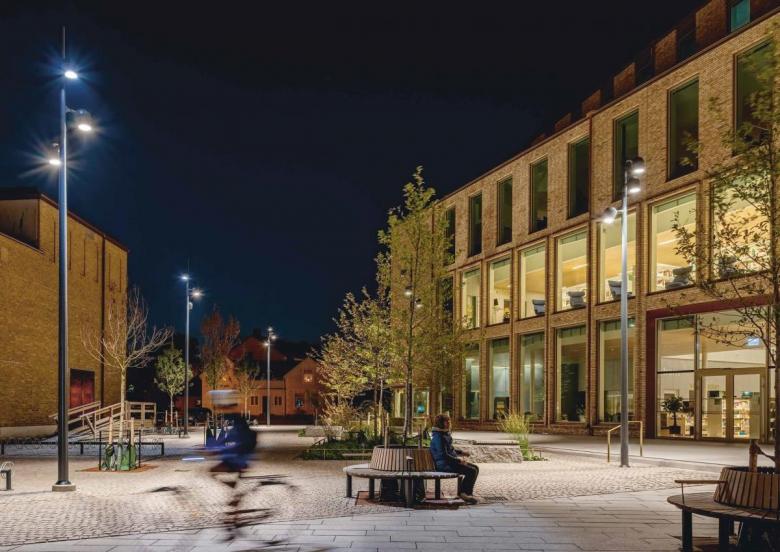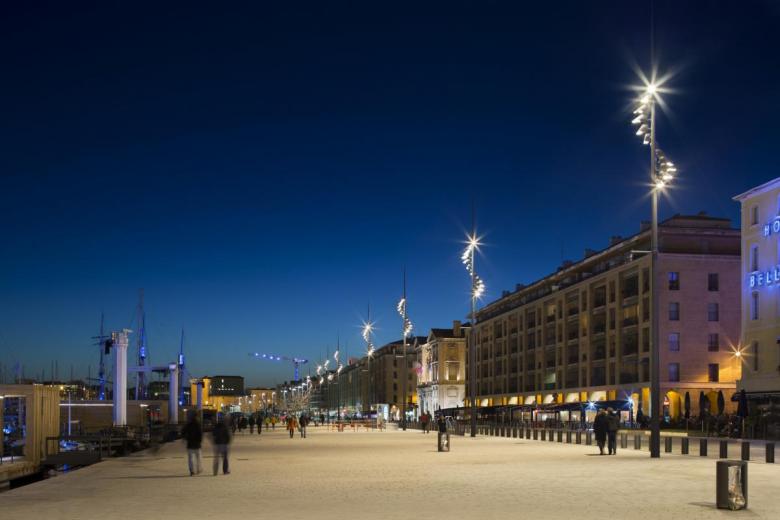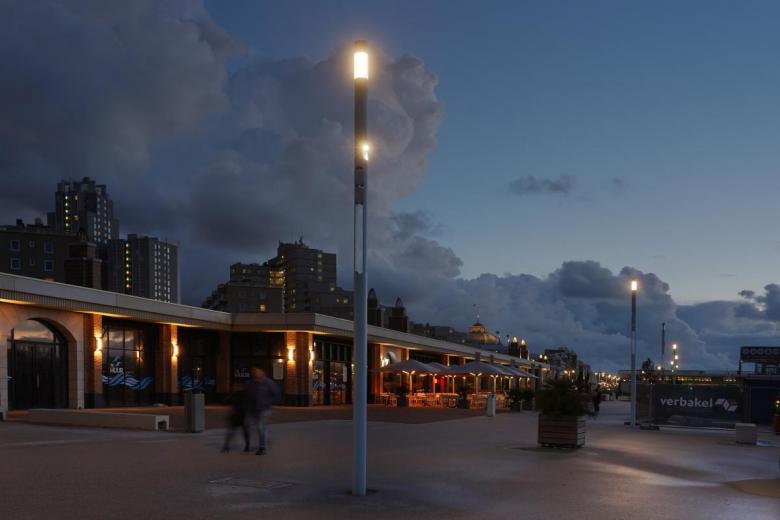Partner - Selux
Light as part of identity-forming architecture
Christiane Fath
10. March 2021
Argus Knowledge and Culture Centre Falkenberg, Sweden (Photo: Werner Nystrand)
In the midst of rapid climatic changes, urban space is also currently undergoing a phase of upheaval: open spaces and regionality are gaining in importance, the city is becoming greener and spending time in urban space is taking on communal characteristics. Architects, the city and its inhabitants are jointly searching for quality at different levels – in structures that are as democratic as possible. In order to create a livable atmosphere in the city, one important element is of particular significance: light.
The internationally active luminaire manufacturer Selux, headquartered in Berlin, has been developing lighting solutions with a special focus on sustainability for almost 80 years. Klaus-Peter Siemssen*, CEO of the company and an industrial engineer, considers timelessness to be “the most effective form of sustainability” – the aim is to create objects that meet aesthetic, functional and ecological expectations even after decades; luminaires that integrate into locations and enter into a symbiosis with the space. The lighting solutions that Selux provided for the Humboldt Forum in Berlin or for the Vieux Port in Marseille also correspond to this quality: they are unobtrusive in the cityscape during the day but show their versatility in the dark. For Selux, nature, with its perfection, intelligence and beauty, is a source of inspiration – Selux is convinced that nature and urbanity are not opposites. The best way to create beauty is to preserve it.
The sensitive use of light in outdoor spaces creates places with a high sojourn quality: trees, paths, materials, façades, artworks, bridges and squares are projection surfaces for light in the city, similar to the blooming behavior in nature. Undifferentiated “carpets of light” are to give way to a sensitively illuminated urban landscape. In this context, the effect of light at night undergoes a significant change in meaning: in the areas of urban marketing, enhancement of the cityscape, street furniture, energy measures and increasing public safety, light represents a tool for emphasizing spatial elements, working out structural relationships and shaping the city’s identity.
In partnership with the Cologne-based architecture firm O&O Baukunst, Selux reflects on light in relation to urban space in the podcast TOWN PLANNING IN DEMOCRATIC STRUCTURES. Using the example of the urban development projects Helios Site and Parkstadt Süd in Cologne, the podcast discusses how light influences the city.
The old port of Marseille Marseille, France (Photo: Xavier Boymond)
Together for the “Heart of Ehrenfeld”Four hectares in size, steeped in history and full of potential – the future of the Helios site, the former company premises of Helios AG in Cologne’s Ehrenfeld district, owes much to a democratic process. The investor’s plan to build a large shopping center on the site of the former lamp manufacturer was criticized by local residents in 2010 in the form of a citizens’ initiative, which culminated in a public participation process two years later. Finally, the mission statement “Lively urban quarter for everyone” was developed for that area’s future use – an innovative residential and cultural quarter, open and accessible for all.
This process served as the basis for the urban planning competition, from which the Cologne branch of the architecture firm O&O Baukunst, founded in 2006 (other branch offices are in Berlin and Vienna) and led by Christian Heuchel**, came out as winner at the end of 2013. “The new buildings should confidently complement the historical Rheinlandhalle and the Helios Tower and provide space for education, culture, living and retail,” says Heuchel. Conceptually, this is an artistic approach, which is not by chance the trademark of O&O Baukunst. With roots in the Haus-Rucker-Co group of architects and artists, the architectural firm founded in 1987 stands for innovation infused with historical heritage.
This considered urbanity is emphasized with the help of light, which also played a central role in the historical development of the Helios site. The planned illumination with historical lamp towers and trees has a particularly atmospheric quality; the possibility of changing, coloring, dimming or emphasizing the light offers numerous instruments for artistic illumination. The lighthouse, which Helios AG formerly used for testing purposes, initially appears rather unusual in the cityscape of Ehrenfeld. However, its signaling power as a signpost becomes a symbol of the democratic movement that is shaping the future of the neighborhood. A light room on Heliosplatz (Helios Square), conceived by O&O Baukunst and painted by artist Mathias Köster, gives additional expression to this strong bond with light.
Another major project is currently being developed on the southern edge of Cologne’s city center. The 115-hectare site around the old wholesale market is to become Parkstadt Süd – an urban district providing 3,500 flats and workplaces for 4,000 people – over the next 15 years. The design by O&O Baukunst and the landscape architects RMP Stephan Lenzen envisages an area for citizens where living, working, social infrastructure and green recreational space will become one.
According to O&O Baukunst, the targeted use of light in the development project is intended to help create housing spaces that once again convey a sense of identity and offer people a quality of life. Local ties are to be secured with the help of the “Colors of Cologne”, a color scheme developed by O&O Baukunst and artist Kirsten Lampert, inspired by antique oil lamps from the cathedral city. The squares will be bathed in different color moods to create a striking effect full of atmosphere, especially at night. The yellowish-white kaolin, the reddish fireclay, the green earth tone and a grey shade created by soot mixed with chalk are to continue the city’s history and ensure the recognizability of the place. The alleyways, boulevards and axes, on the other hand, are bathed in a neutral light. Special attention is also paid to the illumination of the listed market hall, the heart of Parkstadt Süd.
Ecology is the basis for all of this. The goal of the project is to become a plus-energy quarter by 2035. To this end, a lighting master plan is being developed that takes as its basis the city’s transition to the new public green belt. With regard to nature, the green space must be illuminated in a more calming and dimmed way, without neglecting safety aspects.
The creative power of light to generate visual comfort and at the same time emphasize the uniqueness of architecture underlines the identity of the urban space in both projects. At the same time, the ecological aspect is indispensable. A good lighting concept ensures the preservation of identity, takes into account the historical context and exists in harmony with nature – without neglecting the requirements of the users. Safety, mental well-being and aesthetic appeal have a direct influence on the city’s inhabitants – and thusly light, as a consciously used tool in urban planning, is a central component of democratic urban development.
Lif at Noorderboulevard Scheveningen, Netherlands (Photo: JuistInBeeld)
Interactive map
Using selected building projects by O&O Baukunst, the topic is presented taking the city of Cologne as an example. For information on the projects, click here for the interactive map.
«Town Planning in Democratic Structures» is a project of O&O Baukunst Köln, C. FATH and World-Architects.


